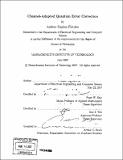| dc.contributor.advisor | Peter W. Shor and Moe Z. Win. | en_US |
| dc.contributor.author | Fletcher, Andrew Stephen | en_US |
| dc.contributor.other | Massachusetts Institute of Technology. Dept. of Electrical Engineering and Computer Science. | en_US |
| dc.date.accessioned | 2008-02-27T22:34:16Z | |
| dc.date.available | 2008-02-27T22:34:16Z | |
| dc.date.copyright | 2007 | en_US |
| dc.date.issued | 2007 | en_US |
| dc.identifier.uri | http://hdl.handle.net/1721.1/40497 | |
| dc.description | Thesis (Ph. D.)--Massachusetts Institute of Technology, Dept. of Electrical Engineering and Computer Science, 2007. | en_US |
| dc.description | Includes bibliographical references (p. 159-163). | en_US |
| dc.description.abstract | Quantum error correction (QEC) is an essential concept for any quantum information processing device. Typically, QEC is designed with minimal assumptions about the noise process; this generic assumption exacts a high cost in efficiency and performance. We examine QEC methods that are adapted to the physical noise model. In physical systems, errors are not likely to be arbitrary; rather we will have reasonable models for the structure of quantum decoherence. We may choose quantum error correcting codes and recovery operations that specifically target the most likely errors. This can increase QEC performance and also reduce the required overhead. We present a convex optimization method to determine the optimal (in terms of average entanglement fidelity) recovery operation for a given channel, encoding, and information source. This is solvable via a semidefinite program (SDP). We derive an analytic solution to the optimal recovery for the case of stabilizer codes, the completely mixed input source, and channels characterized by Pauli group errors. We present computational algorithms to generate near-optimal recovery operations structured to begin with a projective syndrome measurement. | en_US |
| dc.description.abstract | (cont.) These structured operations are more computationally scalable than the SDP required for computing the optimal; we can thus numerically analyze longer codes. Using Lagrange duality, we bound the performance of the structured recovery operations and show that they are nearly optimal in many relevant cases. We present two classes of channel-adapted quantum error correcting codes specifically designed for the amplitude damping channel. These have significantly higher rates with shorter block lengths than corresponding generic quantum error correcting codes. Both classes are stabilizer codes, and have good fidelity performance with stabilizer recovery operations. The encoding, syndrome measurement, and syndrome recovery operations can all be implemented with Clifford group operations. | en_US |
| dc.description.statementofresponsibility | by Andrew Stephen Fletcher. | en_US |
| dc.format.extent | 163 p. | en_US |
| dc.language.iso | eng | en_US |
| dc.publisher | Massachusetts Institute of Technology | en_US |
| dc.rights | M.I.T. theses are protected by copyright. They may be viewed from this source for any purpose, but reproduction or distribution in any format is prohibited without written permission. See provided URL for inquiries about permission. | en_US |
| dc.rights.uri | http://dspace.mit.edu/handle/1721.1/7582 | |
| dc.subject | Electrical Engineering and Computer Science. | en_US |
| dc.title | Channel-adapted quantum error correction | en_US |
| dc.title.alternative | QEC error correction | en_US |
| dc.type | Thesis | en_US |
| dc.description.degree | Ph.D. | en_US |
| dc.contributor.department | Massachusetts Institute of Technology. Department of Electrical Engineering and Computer Science | |
| dc.identifier.oclc | 191822846 | en_US |
